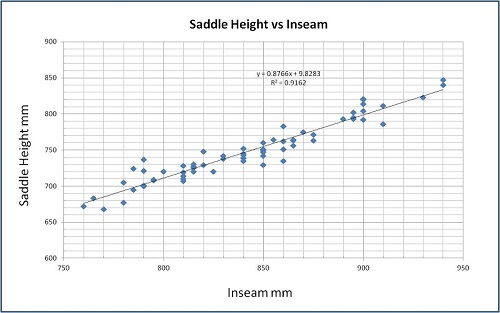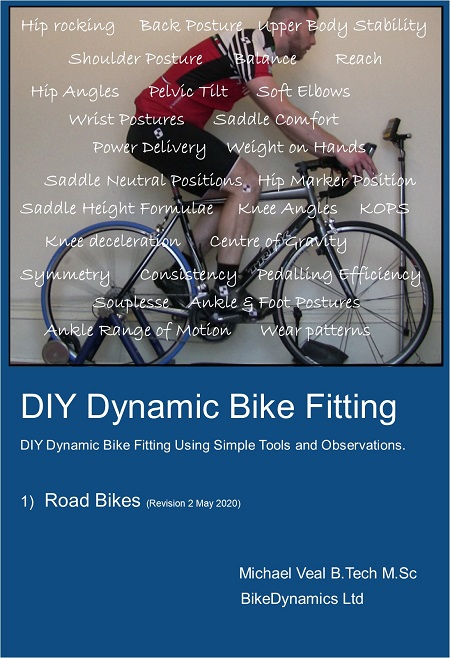Saddle Height Formulae
Some years ago, when first setting up the BikeDynamics business, I was keen to use the Dynamic measuring tools available to me rather than the old static measures and rules. One of these tried and trusted old techniques for establishing saddle height is to measure your inseam and multiply by 0.883. After some time developing my own techniques I decide to compare the outcomes with the multiplyer, giving the graph shown here.
If you can't see the formula on the plot, it is
Saddle Height = 0.8766 (inseam) + 9.8
with an R2 of 0.9162. To those that know their stats this is an OK correlation but not perfect. There was a very slightly better correlation with a polynomial expression, but the improvement did not warrant the added complexity of the equation.
I'm actually quite pleased with this formula because it recognises that the origin is not at zero. We all use similar shoes and pedals with an offset between foot and pedal axis. This formula suggest that offset is 9.8mm, which is probably not that far off the mark!
Although reasonably pleased that my own saddle height correlations were in broad agreement with the generally established Inseam x 0.883 rule, I noted how some customers preferred to be some distance from these predictions. Always keen to improve the Bike Fitting process, I was keen to understand why this was the case and establish means to improve the correlation. Considering how differences may occur led to investigations along two distinct paths:-

1) Measurement error.
Measurement error struck me as a likely major source of discrepancy as I have had the 'pleasure' of watching how hundreds of people respond when asked to hold a 25mm diameter wooden bar 'snugly' against their crotch. Some people seem to want to cut themselves in half and get it as high as possible, whereas others barely touch their shorts. The bar will rarely be horizontal and their feet will often be too far apart. Most of these errors can be corrected, but I still felt that maybe 'Inseam' was not the best measure of leg length. Looking for alternatives, the height of the top of the Greater Trochanter (GT) looked like it could be a good option. This is also the position I use for the hip marker during dynamic motion capture, for the very sensible reason that it is a good representation of the centre of the hip ball joint. For many skinny cyclists the GT is very easy to find with the lightest of prodding, but for others it can be buried under a lot of fat and muscle and hard to define accurately.
I initially thought that the GT height could be used as a 'sanity check' for Inseam, assuming the relationships between them would be fairly constant. This was quickly dispelled as I realised that the difference between Inseam and GT varied widely, with no correlation to one's height. For instance, I would expect the difference between the two measures to be anywhere from 60mm to 120mm, with short people just as likely to have a deep (120mm) pelvis as a tall person. After a few weeks of measuring both inseam and GT height, I was able to start generating new correlations. I was hopeful that I would improve on the R2 = 0.916 noted previously for the inseam correlation, which proved to be the case, but only marginally. The R2 term is an indication of how well the data 'fits' the equation with '1' being the ideal. More importantly, I was still seeing customers who were quite happy with saddle heights up to 20mm away from their predictions!

After further investigation of the stats, I started to realise that for people with a deep pelvis (i.e. 120mm+ difference between Inseam and GT) the GT numbers would over-predict the saddle height and the Inseam under-predict. This is entirely intuitive as whereas a large GT number implies a long femur and tibia, you still need to be able to sit on the saddle at the top of your inseam. Looking to improve the correlation further, I plotted saddle height against a combination of both GT and Inseam in a number of different ratios. The best correlation of R2= 0.9526 was achieved with a simple addition of the two. You might think that setting the saddle height for my customers is now quite straight-forwards, a couple of measurements, a graph and a bit of fine tuning is all you need. This is not the case. I use another eight pieces of information to define the correct saddle height, using the prediction as a sanity check. After going through the dynamic fit process, we will measure the final height and compare this against the prediction. I am usually quite pleased to see that it is within a couple of mm and feel a smug glow as the customer is often impressed. If the actual and prediction are significantly different, I will want to know why, which brings us to the other subject matter of: -
Other variables
With my new correlation working very well for most of the time, I can get a bit perturbed if the numbers are way off (i.e. more than 7-8mm). Further investigation has concluded that this will most likely be due to one or more of the following factors (in order of importance).
1) Foot length.
For most people, their foot length is roughly proportional to their leg length and height. A long foot effectively lengthens the leg and vice versa, so if an actual preferred saddle height is lower than predicted, the person will often have a smaller than average foot. A subset of this category is shoe length. Now most people's shoes are directly proportional to the size of their feet, but I occasionally see customers with shoes way too big for them. Sadly, the excuse is often an unresistable eBay bargain partially ameliorated with thick socks! As well as the shoes being too loose, the hole drillings will be too far forwards putting the cleats in the wrong location. This again effectively lengthens the leg, calling for a higher saddle. There is an article on the web showing the correlation between shoe size and height
"here".
Interestingly the R2 for the data set used is only 0.808
2) Saddle Shape.
Using the lovely piece of measuring equipment shown here, the process to measure saddle height is quite easy and the errors small. The actual measurement I use is from the centre of the bottom bracket, directly along the seat tube axis to the top of the saddle. Suspension seat-posts and very squishy saddles can affect the result, but can also be easily accommodated. Where variability occurs most is in the shape of the saddle itself. If you imagine a saddle with a very domed surface compared to a flat top, the hips could be significantly lower for the same measured height. The most striking example is the unique SMP saddle I use myself and shown here. The very sculpted shape means that the actual measurement is much lower than the effectively same height of a more conventional saddle. If customers come in with an SMP saddle, I will expect their actual saddle heights to be 3-7mm lower than the predicted.
3) Pedals, Shoes and Cleat Stack Height.
Imagine the axis of the pedal spindle and the underside of the foot. The distance between the two is separated by the pedal itself, the cleat, the thickness of the shoe sole, the insole and the sock, not to mention any wedges or shims that a Bike Fitter may have put in your shoes. I have a pair of Specialized shoes for most days and Shimano winter boots for when cold and wet. The pedal system, sock and insoles are identical, but I can immediately feel that the saddle feels lower if wearing the winter boots. My estimation is that the thicker sole and insulation of the winter shoes adds 3mm to the 'stack' height and if going any sort of distance, I'll nudge my saddle up accordingly. Tell me if I'm wrong, but I think the lowest stack height is probably on a Speedplay pedal mounted directly with 4 bolts to the sole of an appropriate shoe. The usual 3 bolt adapted plate will add 3mm, but this is still 5-6mm lower than my SPD-R.

4) Hamstring Flexibility.
Before delving deeper into the subject and getting a better idea of foot length, stack height and saddle shape, I would have told you that Hamstring flexibility was by far the bigger contributor to where the saddle ends up. It is significant, but maybe not as much as first thought. Tight hamstrings will tend to inhibit leg extension, so the saddle may need to be down a mm or two. Customers with tight hamstrings continually confound me with higher than expected saddles, as do the very flexible with low.
Summary
Many Bike Fitters and cyclists will successfully use the simple relationship
Saddle Height = 0.883 x Inseam
But should be prepared to experiment with a significantly higher or lower saddle to find an optimum. A better relationship is to use the term:-
Saddle height = f (Inseam + Greater Trochanter) + c
Whereas the perfect relationships will include all the terms above i.e.
Saddle height = f1 (Inseam +Greater Trochanter) + f2 (foot length, stack height, saddle shape, hamstring flexibility) + c
I am quite happy with my Inseam and GT correlation for now. Generating new data all the time, I would hope to be able to introduce a suitable foot length and stack height term, but unfortunately saddle shape and hamstring flexibility are a bit subjective and maybe difficult to turn into numbers. You will note that I have not shared the equation I am using currently (with both GT and Inseam), which you may think unusual for me as I have tried to share as much of my knowledge as possible on both website and blog. This now represents significant intellectual property, which I can't afford to just give away. I am happy to sell it quite cheaply though via a PDF download available below. This also discusses the other eight observations and measurements mentioned above, as well as the methodologies to define saddle fore/aft and handlebar positions.
DIY Dynamic Bike Fitting
You may be interested in our downloadable DIY guide.
45 Page PDF download describing all the observations, simple measurements and calculations required to do your own Dynamic Bike Fits.
Revision 2 released May 2020.
Contains updated male and female saddle height calculators and new information on male / female leg length proportions. Plus a new section to assist with saddle choice and improving comfort.
British Pound, Euro and US Dollar payments are processed by PayPal and all major credit cards are accepted. You will receive an email confirming your payment and will be automatically redirected to a page where you can download the ebook. The ebook is in PDF format so you will need to have a copy of Adobe Acrobat Reader or a similar PDF reader to read the ebook.


